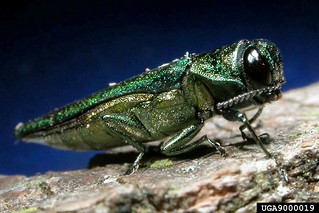Spread by firewood, tree-killing pest confirmed in Arkansas
July 21, 2014

Fast facts
- Emerald ash borer confirmed in Hot Spring, Clark, Nevada counties
- Arkansas could be added to federal quarantine
- State official surveying surrounding counties to assess potential spreading
- Tree-killing insect likely spread through movement of firewood
(570 words)
HOPE, Ark. – The emerald ash borer, a tiny Asian insect responsible for the deaths of tens of millions of trees since its accidental introduction to the United States in 2002, has been confirmed in Hot Spring, Clark and Nevada counties, according to the state Plant Board and the Arkansas Agriculture Department.
What happens next will be of concern to homeowners, policy makers and baseball fans.
The discovery may mean adding Arkansas to a federal quarantine that bars movement of firewood and nursery stock out of the quarantined area to slow the insect’s spread.
“I think the emerald ash borer’s impact will be huge,” said Tamara Walkingstick, associate director of the Arkansas Forest Resources Center.
In states already afflicted by the borer, ash trees are being cut down and removed to prevent the insect’s spread.
“Shade tree loss and cost of removal in urban forests could tally in the millions of dollars,” she said.
“There goes the one ash tree in my front pasture,” said Jim Robbins, an extension horticulture specialist-ornamentals, for the University of Arkansas System Division of Agriculture.
Emerald Ash Borer -- Known as EAB, this tiny insect has been enormously destructive
in states where it has been found.
CREDIT MANDATORY -- Image by David Cappeart, Michigan State University. Image via
Bugwood.org.
There’s another cost too. “You like baseball? Wood bats are made from ash. They do have commercial value,” said Jon Barry, extension forester with the University of Arkansas System Division of Agriculture.
Spotted by surveys
Since 2009, the Arkansas State Plant Board and the USDA Animal Plant Health Inspection Service, Plant Protection and Quarantine, have been conducting surveys to detect the borer, using traps and inspecting ash trees for signs of infestation.
The insect, a mere half-inch long, has expanded its range by hundreds of miles during its 12 years in the U.S. It was first discovered in southeastern Michigan. In 2008, it was found in southeastern Missouri.
While its appearance in Arkansas was not unexpected, “the only surprise was finding it first in south Arkansas,” Barry said.
“The emerald ash borer should be able to spread only a few miles a year by flight, but it has been spreading by leaps and bounds instead. How has this occurred?” Barry said. “The most likely culprit in the spread of the borer is us -- people. People move firewood, sometimes firewood that is infested with the emerald ash borer, and in the process move the pest.”
Firewood should be sourced locally and burned locally, state officials said.
Signs of infestation
Signs of infestation include:
- Multiple jagged holes excavated by woodpeckers feeding on ash borer larvae,
- Distinctive D-shaped exit holes left by emerging adult beetles,
- Multiple dying branches with wilted leaves, especially when accompanied by new limbs sprouting near the base of the tree,
- Canopy dieback from top of the tree,
- Sprouts emerging from roots,
- Larval tunnels or galleries immediately under the bark of dying ash trees.
Barry said if any of these signs of infestation appear, contact your county extension agent or call the Arkansas State Plant Board at 501-225-1598.
State and USDA APHIS PPQ personnel will now survey trees in the areas surrounding the initial finds to determine the extent of the emerald ash borer infestation. It is expected that a federal quarantine will be expanded to include parts of Arkansas and potentially the entire state.
For more information about the emerald ash borer, visit www.emeraldashborer.info or www.arinvasives.org. A fact sheet about the borer may be found at: “Emerald Ash Borer: A potential pest of ash trees in Arkansas”, downloadable at www.uaex.uada.edu/publications/pdf/FSA-7066.pdf.
Pursuant to 7 CFR § 15.3, the University of Arkansas System Division of Agriculture offers all its Extension and Research programs and services (including employment) without regard to race, color, sex, national origin, religion, age, disability, marital or veteran status, genetic information, sexual preference, pregnancy or any other legally protected status, and is an equal opportunity institution.
By Mary Hightower
Cooperative Extension Service
U of Arkansas System Division of Agriculture
Media Contact: Mary Hightower
Dir. of Communication Services
U of A Division of Agriculture
Cooperative Extension Service
(501) 671-2126
mhightower@uada.edu
Related Links
